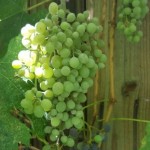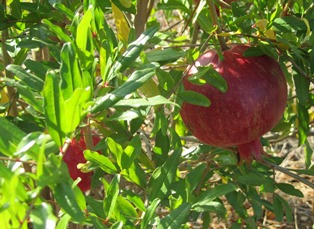The Summer Garden Is Done, What’s Next?
My summer garden is wild and chaotic and bountiful at the beginning of the season. You’ll find fruit trees, vegetables, vines of melons, corn, and perennial lavender and other showy herbs and flowers. Like a grand dame of faded elegance, the garden has matured and looks a bit weary and spent now that Labor Day approaches.
Just because the peak growing season is coming to an end, it’s not the end of garden chores. The following tasks can be started now.
HARVEST AND STORE
For some crops, the harvesting goes on. Examples include tomatoes, potatoes, melons, and winter squashes like Butternut that store well. If you haven’t already harvested the garlic, it’s a good time to do that.
Cut sunflower seed heads and place them in a warm area to dry. Collect seeds from cosmos, nasturtiums, and other flowers to preserve for next year’s garden. Work out storage options, especially for food items to be harvested.
Snip summer table grapes and other varieties if they are ripe . . . or let them hang a while longer for extra sweetness.
CLEAR BEDS
Depleted, dying, or dried annuals can be dug, pulled, and composted now. If you plan to let the garden rest, plant a cover crop so the ground doesn’t become hard scrabble. The cover crop will feed the soil.
DO FALL PLANTING
If you intend to do a fall planting, take time now to enrich the earth with amendments. Turn and rake the garden soil. Put plants directly into the prepared earth and water well to get them off to a good start.
For quick second crop before the weather turns cold, plant greens such as spinach, kale, and arugula. Cool season crops like beets, broccoli, and cabbage can go directly into the ground now, too.
CUT FLOWER AND SEED HEADS
Cut flower heads of hydrangeas for drying. Insert plant markers near peonies and other perennials that will die completely back during winter. Gather bunches of mint and other herbs, tie with string, an hang in a cool, dark place to dry.
CREATE MULCH
Designate an area to create a new compost pile. Use garden detritus and fall leaves as the trees begin to drop their canopies to enter winter dormancy. The resulting mulch will enrich the soil for next year’s garden.
CHECK ON FALL PRODUCE
Pomegranates, persimmons, and pumpkins will soon be ripening. Ensure that these plants continue to get water. Check for pests and any signs that might indicate nutrient deficiencies that could show up in the leaves. Figure out your options for storing or gifting excess fruits and veggies. For example, pomegranates keep well in the fridge or remove the seeds and put into bags for freezing. Save and dry rinds for potpourri.
TURN THE SOIL IN GROW BOXES
Aerate and amend soil in grow boxes and raised beds for cool season crops. Do these chores before the rainy season and cool weather arrives. Your garden, like a young maiden who flourishes from attention, will produce bountiful vegetables, fruits, berries, and flowers during its next growing season.
_______________________________________________________________
If you enjoy reading about farmette topics, gardening, and keeping chickens and honeybees, check out my series of cozy mysteries from Kensington Publishing in New York.
Click on this link: http://tinyurl.com/ya5vhhpm
My newest nonfiction book is published by Adams Media/Simon & Schuster: http://tinyurl.com/y9vfw2t9
- Anyone can find peace, clarity, and focus…all it takes is a moment
What’s Growing in the July Garden?

Sunflowers are native to North America and were taken to Europe in the 16th century; however, they date back to roughly 3,000 B.C. Honeybees love sunflowers.
Towering above the squash and lavender in my garden are rows of green corn stalks bearing ears of sweet, plump kernels. Snaking along the rows at the base of the cornstalks are vines laden with butternut squash and Armenian cucumber.
There are ripe tomatoes, too, especially the prolific heirloom–Red Beefsteak. I love cutting up some of these fresh, thin-skin tomatoes and combining them with basil, olive oil, grated cheese, and pine nuts as a topping for pasta. Add some grilled, seasoned chicken and you’ve got a quick and delicious summer lunch.
Zucchini and yellow squash sport large, showy blooms and are producing like crazy this month. While you can harvest and eat the blooms, we prefer the squash. Zucchini is delicious grilled or tossed with rosemary potatoes and onions or made into a French lentil and tomato salad (see recipe from last week’s posting).
Growing on vines trained over a wall and on supports, the green table grapes are beginning to swell. The taste is still a little tart, but will sweeten with the passage of another couple of weeks.
* * *
If you enjoy reading about farmette topics (including gardening, beekeeping, and delicious recipes), check out my cozy mysteries A BEELINE TO MURDER and also THE MURDER OF A QUEEN BEE in the Henny Penny Farmette series (from Kensington Publishing).
These novels are available through online retailers such as Amazon, Barnes & Noble, Kobo Books, and Walmart as well as from traditional bookstores everywhere.
Now available in mass market paperback, this debut novel launched the Henny Penny Farmette series of mysteries and sold out its first press run.
COMING SOON: The second cozy mystery in the Henny Penny Farmette series, available Sept. 29, 2016
Garlic–A Staple of Any Kitchen Garden
No proper kitchen garden would be without a section for onions (whether spring green onions, chives, or bulb onions) or garlic. Both kitchen staples are easy to grow. In several raised beds measuring four feet by six feet, I’ve planted garlic amidst a few jalapeno pepper plants. Garlic benefits other plants in the garden as well.
BEST TIME FOR PLANTING
In spring, after all danger of frost has passed, plant garlic cloves. Or, plant in late fall when you might be planting other types of bulbs. Some European gardeners swear that garlic must be planted on the shortest day of the year, the winter solstice.
I planted my garlic in late February/early March, long before my tomatoes, eggplant, pumpkin, and squash (the heat lovers) went in. The green garlic tops shoot out of the soil quickly and grow fast.
HOW TO PLANT GARLIC
Plant each clove from a bulb upright in soil roughly one-inch deep. Space the cloves four-inches apart. The growing site must receive full sun. Give the garlic a good watering each week. Garlic is a beneficial companion plant in the garden because of allicin (a property that acts as a fungicide and pesticide), especially when planted near lettuce and cabbage where it will deter aphids.
HOW TO HARVEST AND STORE GARLIC
When the tall green shoots of the garlic become dry and turn brown, it’s time to harvest the garlic bulbs. After you’ve pulled the bulbs out, shake off the dirt (never wash) and then hang the bulbs in a dark, dry place. Then when the bulbs are completely dry, you can braid the paper-dry tops to hang the garlic in the kitchen for easy access.
Finding Surprises in my December Garden

Open-pollinated, heirloom tomatoes produced lots of tasty fruit over the summer, but . . . in December?
It’s the second week of December and the Winter Solstice is about to arrive next week. Walking through the bleak garden landscape, I wasn’t expecting any of my summer plants to still be producing. But surprise, surprise.
A cluster of red grape tomatoes were still clinging to a vine that had become overgrown by weeds. Not only was fruit still hanging on the vine, but the plant was setting up new blooms. I can only assume the reason for that is that we’re having unseasonably warm temperatures in the Bay Area.
I harvested a 10-pound bag of red and yellow onions at summer’s end. Now I’ve got a new bed where the onion heads re-seeded. I do hope these bulb onions make it through to spring. I might just build a cold frame over them.
In raised beds, the jalapeno and Thai chili peppers that wilted and drooped during the terrible drought this summer have responded to recent rains with lots of ripe peppers and also new blooms.
It’s very strange as these babies need water and high heat; our Bay Area temperatures are hanging in the 60s Fahrenheit during these early days of December.
I harvested the pumpkins and squash but hadn’t yet pulled out the old vines for composting. The hard-skinned pumpkins and squashes can be peeled, cut into cubes, and frozen for use later in culinary creations such as soup.
Further on, I picked the last of the persimmons and pomegranates. These are my favorite fall fruits. And if you’ve ever dropped ripe pomegranate seeds onto the ground, you’ll soon see that the chickens love them, too.
Having uncovered all the garden’s surprises, my thoughts turn to how I’m going to lay out the garden next year and which heirlooms to grow. The garden soil needs to rest as we Bay Area gardeners welcome the rain now that the Pacific storm door has finally opened.
Outwitting the Moles
Last year, our garden went under siege to moles, voles, and gophers. They drove us crazy with tunnels, tracks, and earth mounds–the means to devour our newly planted bulbs and plants. We didn’t see signs of the voles but we knew we had them, too, when one showed up drowned in a post hole after a rainstorm.
But whether the rodent is a gopher, vole, or mole, they are unwanted pests in my garden. This year, my husband and I decided they could roam around if they wanted, but we were going to protect our plants one way or another.
For our heirloom blue tomatoes, Carlos built four -by-six feet boxes to hold soil. For each, we nailed small-hole poultry wire over the bottom, then flipped the box over to set in place on the ground.
We then filled the box with alternating layers of natural soil, compost, and dried horse manure (any type of manure must be dried and aged or it’ll be hot and kill your plant).
We planted, staked, and watered the tomatoes. We’ve seen no evidence of rodent tunnels despite having planted in an area where we know there are tunnels. We’re thrilled with the result. I just may have to do my whole garden in boxes next year.
Stressed-out Tomatoes and Corn
This has been a tough season for my tomatoes because of the heat wave California (and the southwest) recently endured and the gophers that showed up early.
The heat topped out at 105 degrees Fahrenheit on my patio this week. The patio isn’t far from my garden where I have heirloom tomatoes and corn growing. There are cherry and grape tomatoes, slicing tomatoes, a tomatoes for paste. I’m also growing there and elsewhere on the property patches of corn, eggplant, pumpkins, summer squash, and other veggies.
Just when the second planting of corn in my garden had reached the fragile pollination stage, the heat wave hit. Such extreme summer heat stresses corn. In just one week, despite all the watering, an entire section of the corn dried, the moisture of the ears diminished, and some of the dried tassels blew away in the hot wind.
I’m worried that with the global warming problem, we Northern Californians who have always enjoyed the Mediterranean climate here will be experiencing more of this intense heat in coming years.
Garden Tuck-ins and New Plantings
From our Henny Penny Farmette organic garden, I am already harvesting tomatoes, squash, eggplant, peppers, cantaloupe, and ears of corn. But just because I’m harvesting crops now doesn’t mean I’m finished planting for the year.
In fact, in late June and July, while I am enjoying the healthy summer bounty from our garden, I like to think about what else I might plant, like more corn as a succession planting, or tucking in something new where onions or lettuces have been pulled.
In Northern California, we have the dry season (hot weather) and rainy season (cool and wet). The weather is temperate and I have learned to plant vegetables according to when they grow best.
This is the perfect time to plant beans, corn, melons, parsnips, potatoes, pumpkins, radishes, rutabaga, and turnips.
Then as the months of the fall season approach, I plan to tuck in a few cool season crops (bok choy, cabbage, carrot, fava bean, lettuces, peas, radicchio, and spinach) and root vegetables such as turnips, leeks, and onions.
Experiment with New Varieties of Tomatoes and Peppers
Tomatoes are one of my favorite plants from the summer garden. So it’s not surprising that of all the seed catalogs that I get each spring, the Tomato Growers catalog is one of my favorites. It offers 60 full-color pages of mostly tomatoes, but also peppers and eggplant varieties, a listing of equipment and supplies (for example tomato strainers), and books for gardeners. See, http://www.tomatogrowers.com/
I voraciously read all the catalog copy about each type of tomato and pepper and then note the seeds I want to grow. Experimenting with different varieties enables me to experience new flavors, new textures, and other unique characteristics of each variety.
In early spring when my neighbors rush off to garden centers for seedling tomatoes shipped to local nurseries by growers, I begin the process of planting my tomato and pepper seed in cell flats. The flats remain in the warm kitchen until the plants have emerged and have four sets of leaves. Only then do I place them in the garden to allow them time to acclimatize (harden off).
Removing the plants from their cell packs, I plant the seedlings in a basin or hole with native soil mixed with chicken manure or vegetable food. In that basin, the tomatoes benefit from the warmth of the sun and deep watering after transplanting. I do not plant the peppers in basins.
Stressing the tomato plant by withholding water yields tomatoes higher in flavor but can reduce the size and quantity. Too much water, however, can leach nitrogen and other nutrients from the soil and cause the plant to produce lots of leaves but fewer blossoms and fruit.
Near the heat-loving tomatoes in my garden, I always tuck in a few bell peppers, pickling peppers, and hot chili peppers. The Serrano peppers are pungent like jalapeno peppers and measure roughly 5,000 Scoville units of heat. Other peppers such as the Trinidad Perfume and the Fooled You peppers have no heat but are prized as seasoning for dishes requiring peppers.
A word of caution about growing tomatoes. Don’t plant them in the same area of your garden more than three years in a row. Experts say move them around as tomatoes are heavy feeders and putting them in depleted soil or soil in which you’ve grown tomatoes that have become sick can infect your new plants.
If you are interested in the pros and cons of dry farming tomatoes (meaning reduced watering) for intensive flavor and higher sugar content, check out the interesting article on the Growing For Market newsletter. See, http://www.growingformarket.com/articles/Improve-tomato-flavor
 Facebook
Facebook Goodreads
Goodreads LinkedIn
LinkedIn Meera Lester
Meera Lester Twitter
Twitter






























